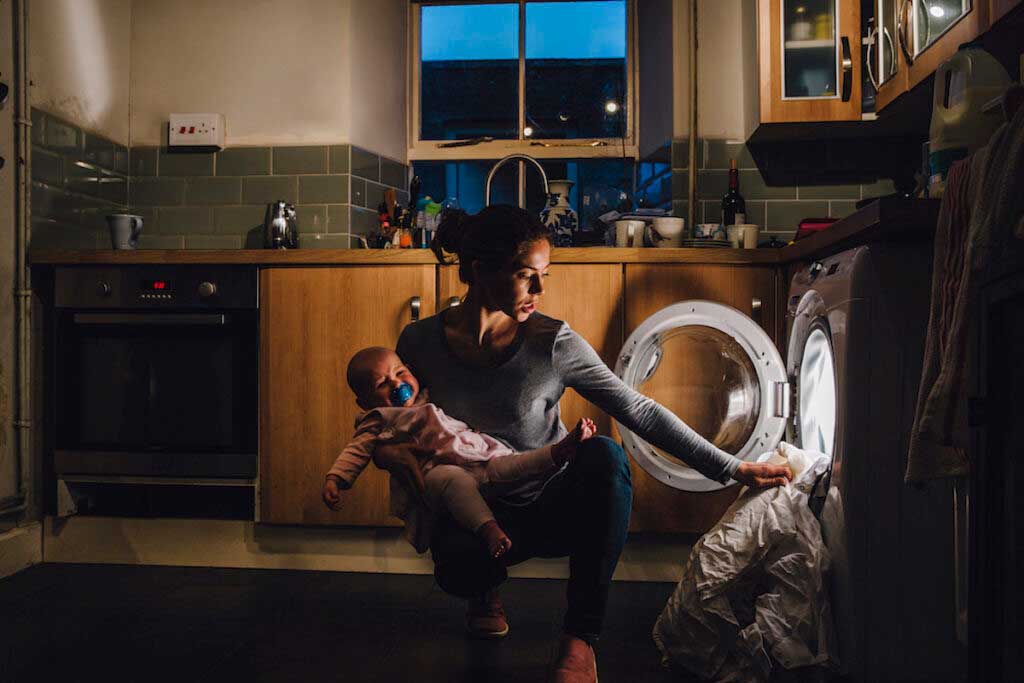It is no secret that kids affect careers. We love our kids! But they take time and energy, and they get sick a lot. For many people, the period of having young children is one in which job and career falls a bit by the wayside.
This is true for both men and women, but when we look at the data, it’s more true for women. The “motherhood penalty” in earnings is much larger than the “fatherhood penalty.” In fact, in some data, there is actually a fatherhood bump in earnings. The motherhood penalty worries many of us; it feels like women and men should be able to have both family and a career. What is driving it?
It is easier to engage with these challenges if we have facts. So today I wanted to highlight some facts — largely from the economics literature — about the impact of children on employment and wages for women and then talk through what we learn from them about possible solutions (and to what problem).
What is the motherhood penalty?
Wages and employment for women drop after they have children, more so than they do for men. This has been documented by a number of authors, and is straightforward to see in graphs. For example, consider this 2018 paper by researchers out of Princeton and Yale. The authors use several datasets from the U.S. to document the changes in the probability of employment after motherhood. Their primary findings are in the graph below, which shows how the employment of women changes around the birth of their first child.
Depending on the time period, the drop in employment is between 42% and 27%; the larger drops are in the older cohorts of mothers. These are enormous changes. And notably, employment rates largely do not recover over the decade after the first birth.
Data from Denmark shows the same pattern of drops, though smaller. There, the long-run reduction in employment is about 20%. As in the U.S., the data shows large drops in the first year after birth, and little rebound. These patterns show up in hours worked and in wages. In the data from Denmark it’s also clearly apparent that men do not see a similar dip in any outcome.
Other research allows us to narrow in even more directly on the role of children by holding constant more characteristics. Researchers in Sweden explored this question within families, by looking at the yearly income for members of the same couple — men and women, in their analysis — around the birth of a first child. Their graph below shows the clear impact of childbirth on the gender gap, and the long-term impacts. And this is Sweden! Arguably among the most gender-egalitarian societies.
A final point in the fact base comes from a 2010 paper by three economists that looked at the earnings of graduates from an elite MBA program over time. This is not a representative sample of workers, of course. However, it’s a group where we can be confident their training and qualifications are similar, so they are starting on similar footing.
The paper finds that initially earnings are similar but that they diverge over time. And the authors find that the main reason for this is differential responses to childbearing. Women are more likely to step back from or out of the labor force when they have children, even relative to their similarly trained male peers.
To summarize: When children are born, women experience a significant reduction in labor-force participation and earnings. We see this overall, within families and within groups with very similar training. It seems clear, in a mechanical sense, that the cause of these changes is the presence of children.
The more complicated questions are why this happens, and what (if anything) should be done. Addressing these would require much, much more than a single article. But I’ll offer a few thoughts below to get your juices flowing.
Why does this happen?
One simple answer to why this happens is some direct discrimination or rules. Certainly there have been times and places where having a child — or even being married — automatically took women out of the labor force. And it remains the case now that pregnancy discrimination and parenting discrimination is an issue for many women. This is a more significant problem for many low-income women, and it is one we can imagine affecting with policy solutions.
However, we know from much of the data that this type of direct discrimination is not the entire story. We see employment and income declines in locations and in individuals where these factors are not likely to be as present.
Once we are out of that direct realm, this becomes a complicated question to answer. In a sense, we’d like to separate out “choices” and “constraints” as possible explanations. One story is that the decline in labor-market participation is a freely made choice: some women would prefer — even completely unconstrained — to be at home with children rather than working, and therefore they choose to do so. A second story is about constraints: women would like to return to the workforce, but they are constrained by lack of job flexibility, by lack of child care, by other societal burdens.
It is important to understand the relative contribution of these: one of them is something we’d like to fix, and the other isn’t. If this is an unconstrained choice and everyone is happy with it, then it’s not clear what the problem is. If instead it’s a constraint, there is scope to ask what changes in government or corporate policy might change things.
Separating out choice and constraint is a thorny problem, and it’s not always clear where one starts and the other stops. The reality is that we all make choices under constraints. If there are limited good child care options, or my job doesn’t provide the flexibility I want, I may choose to stay at home. This is a real choice, but I might make a different one without the external constraints.
A complicating aspect of all of this is the way that any constraints interact with gender equality. In principle, a constraint like limited child care should affect parents equally. But it doesn’t. And the reason why is likely an economic one. Imagine that a couple has a child and decides it makes sense for them, collectively, to work 20 fewer hours a week so they can cover more time with the child. Because of the way the labor force is organized — because in many jobs there is no real part-time option – it often makes financial sense for one person to drop from 40 to 20 hours, rather than both to drop from 40 to 30. Or it may even make sense for one person to completely leave the labor force for some period. This inherently means the burden is split unequally, that one person is taking a larger hit.
This wouldn’t have to be the woman, but it often is, either because they are already taking time with the child or because there are already small differences in their career trajectories. In this way, small differences before kids become bigger differences after.
In this way, constraints that are in principle gender-neutral actually turn out to favor men.
What can we do about it?
One way to think about a solution is to try to remove constraints. If we had better child care, better parental leave, and better resources for families, we’d get less gender inequality in these metrics. On one hand, the comparison of the U.S. with the data from Denmark or Sweden does suggest that those conditions would help. The relative drop in employment for women in the U.S. is much larger than in Denmark. On the other hand, these large differences persist even in countries with many fewer constraints of this type.
Claudia Goldin, an economist at Harvard, has another take, more focused on the characteristics of jobs. Her basic argument is that a central issue driving the continued lack of gender equality is “greedy work”: the basic fact that, in many jobs, part-time work isn’t really available, or takes people off a career trajectory. In jobs like this, equality is hard to maintain.
This isn’t true for all jobs. For example: together with another economist, Larry Katz, Goldin argued that in a job like pharmacist, where working half-time pays about half as much as working full time, there is a lot of gender equality. Working half-time is also not unusual for pharmacists, and that decision doesn’t ultimately impact their career trajectory. They contrast that with a field like corporate law, where going down to 20 hours a week is effectively stepping off a career track. Those fields have less equality. (More on this argument in a very accessible piece here.)
That is one answer. With a complex problem like this, no single answer is going to explain everything. And the unfortunate reality is that with such a complicated problem, sometimes things that seem like solutions actually make things worse.
To give a concrete example, in academia a central problem is that the “tenure track” period overlaps with a period in which many people have children. You have a small number of years (typically six to nine) over which to produce enough work for your university to decide if you should get tenure. If two of those years involve having a child, there may be a disadvantage to women.
In an effort to improve circumstances for women, many universities introduced a rule in which you get an additional year on the tenure clock when you have a child. However, they didn’t just want to introduce this rule for women; doing so would imply that men aren’t responsible for children! In most places the policy was gender-neutral: both men and women got an additional year.
The result, at least in economics, was the opposite of what was hoped. When these policies were introduced, the tenure rate for women went down and for men it went up. The overall impact was to worsen, not improve, gender balance.
You might say, “Well, that was a bad policy — women should have gotten more time.” And yet that’s also a bad policy in a lot of ways. Echoing the original concern, it would amplify the idea that only women should be responsible for children. It’s unfair to men who are the primary caregivers. Intermediate policies have been proposed — birthing parents get an extra course off, for example — but they all have their own significant issues.
This, to me, is a stark illustration of why creating effective policies is a challenge, and one that will defy efforts at easy solutions. There is some low-hanging fruit: better parental leave, for example, which would let women spend time with their newborns without detaching from the labor force. But providing unconstrained opportunities for everyone requires deeper thought and creative solutions. They are ones we should pursue.
The bottom line
- Wages and employment for women drop after they have children, more so than they do for men.
- There are a number of theories about why this happens, including discrimination against pregnant women and parents. However, the data on this point isn’t definitive. If we had better child care, better parental leave, and better resources for families, we’d likely see less gender inequality in these metrics.
- The motherhood penalty is a complicated problem with a complicated (currently unclear) solution. It will take societal, and in particular policy, change to make a difference, and it is worth pursuing.
















